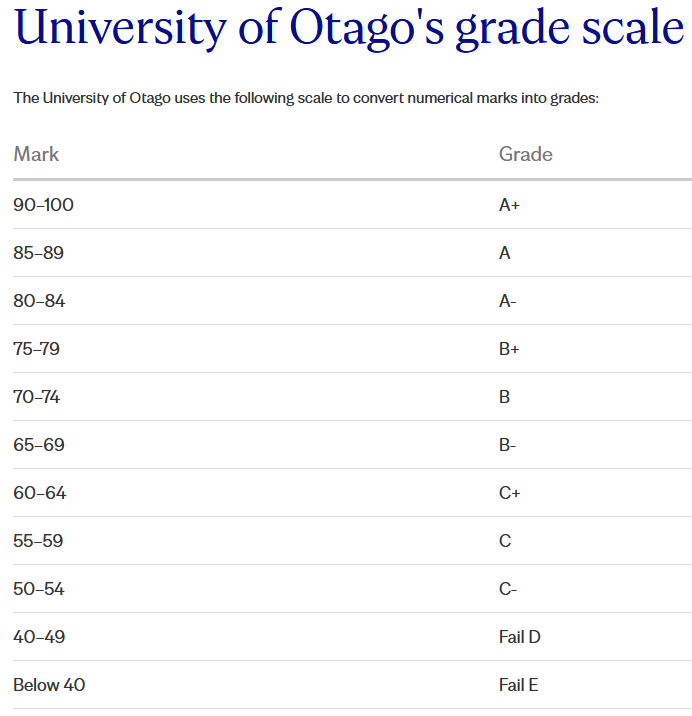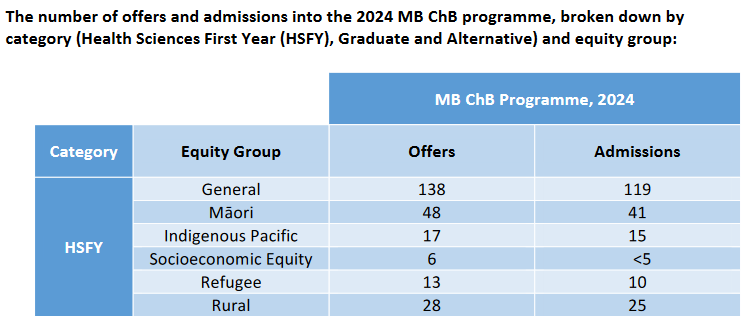Find out what grades you need to achieve in HSFY to get into medical school and dental school at Otago Uni, how to calculate your grade average, what the criteria for UCAT are, what the differences are for international students, what equity groups there are and how this can affect your entry
Click here to see the 2025 numbers for HSFY and graduate entry into medicine and dentistry!Note: This article contains my opinions based on my knowledge and experience. The information in this article should not be construed as personal advice as every person will have different circumstances. Tom Lee Tutoring operates independently and is not affiliated with, employed by, or endorsed by the University of Otago.

Table 1. University of Otago's grade scale
HSFY is the first year of university study for many students, who will then go onto various degrees, including the health professions such as medicine, dentistry, physiotherapy, pharmacy and medical laboratory science. The grades achieved in this year are used to determine entry into medical school and dental school, along with a threshold which must be achieved in the UCAT.
Entry into medical school and dental school are both highly competitive as there are many more students that want to get in relative to the number of positions available.

Te Kauae Parāoa is the policy that guides criteria for admissions for domestic students to the health professional programmes at University of Otago. It is the unfortunate truth that access to educational opportunities is not equal among all members of society. This policy aims to create a health workforce that reflects the ethnic and social background of the community that it serves.
"It is hoped this policy will continue to promote and facilitate equity for students from underrepresented priority groups: Māori, Pacific, rural, socioeconomic and refugee background." from the Uni's
webpage on the policy. Here are the equity groups that the University of Otago currently takes applications under:
- Māori (verification of ancestry is necessary)
- Indigenous Pacific (verification of ancestry is necessary)
- Socioeconomic Equity
- Refugee
- Rural
More details on equity groups can be found on the Uni's website
here If you are not eligible for one of these equity groups, then you will apply under the General category.
As a general rule, the grade average required to get into medical school and dental school under these equity groups is lower than the grade average required for entry under the HSFY General category.
Empty space, drag to resize

Table 2. Official Information Act request response showing the number of students admitted through each sub-category for HSFY in 2024. Original document can be accessed here 
There are a limited number of spots for international students in medical school. I'm not sure of the exact numbers but I estimate there are about 10-20 spots each year.
They apply under the international category and this is also quite competitive, in some years the minimum grade average to get in can be higher than for General category, from what I've heard.
An important note for international students considering studying medicine in NZ.
Most international students studying medicine in NZ want to continue living in NZ and work in the NZ healthcare system. However, in the application for jobs as a first year doctor, international students have the lowest priority for selection.
This means that the majority of international students graduating from a medical school in NZ will not have a job secured in NZ at the time of graduating, unlike domestic students. This is because the NZ government does not fund enough 1st year house officer positions relative to the number of graduating doctors (as at 2024). A NZ or Australian citizen that has graduated from an Australian medical school will be prioritised over an international student that has spent the last 6 years studying in NZ, and has been training in the NZ hospital system for the last 3 years.
Despite this, most international graduates will be offered a job at a NZ hospital within a few months of graduating. However because of their low priority, it will be unlikely that they would have liked to go to. Contrast this to domestic students, where 90% of first year doctors will be allocated to one of their top 3 city choices.

You must also achieve a minimum score in the University Clinical Aptitude Test (UCAT) in order to get into medical school.
For 2024, the minimum threshold was as follows for General applicants:
- Verbal reasoning - 20th percentile
- Situational judgement - 10th percentile
The minimum UCAT thresholds are different for equity groups and this information was not publicly available.
UCAT is no longer a requirement for entry to dentistry.
Reference
A+ PHSI191 with A+ guarantee
All 6 modules of PHSI191 physics - mechanics, solids and fluids, thermodynamics, electricity, optics, radiation
$499
Only $299 with code EB200 (expires 31 Dec 2025)
-
online course with essential PHSI191 content
-
Access to online community
-
advanced content
-
A+ guarantee or your money back
(Terms and conditions apply)
-
Learn advanced problem solving skills for PHSI191, as well as the essential physics concepts and skills. This gives you access to the course until June 2026.

The grade average is used to determine entry into medical school and dental school. This is calculated by using your top 7 paper scores in HSFY.
There are 7 compulsory papers in HSFY:
4 papers in Semester 1 - HUBS191 (human body systems), CELS191 (cellular biology), PHSI191 (physics), CHEM191 (chemistry)
3 papers in Semester 2 - HUBS192 (human body systems), BIOC192 (biochemistry), POPH192 (population health)
You may take an optional 8th paper in Semester 2 from the
approved list, and this can be used to replace your worst paper out of the 7 compulsory papers.
If you want to find out whether you should take an 8th paper in HSFY, read about my thoughts
here.Here are the numbers for 2024 entry into medical school and dental school, so for students that took HSFY in 2023. Previous years have similar numbers (except for 2020, the year of COVID when exams were held online).
Medicine
For medicine through the HSFY General category at University of Otago, the minimum grade average for a first round offer was 95.43%. For a final waitlist offer, this was 89.57%.
First round offers are made around 18 December, while the person that got in with a grade average of 89.57% would likely have been notified in the week of medical school starting in February.
I don't know about you, but I'd much rather get a first round offer than not know whether I've gotten into med or not until the week of school starting.
Dentistry
For dentistry through the HSFY General category at University of Otago, the minimum grade average for a first round offer was 96.29%. For a final waitlist offer, this was 90.14%.
You can see you actually need higher grades (only slightly) to get into dentistry. This is likely because there are fewer spots available for dentistry each year (only about 90) and also the fact that there is only 1 dental school in NZ (whereas there are 2 medical schools, potentially to be 3 in the near future?)
This means that you need at least a ~90% grade average to get into medicine or dentistry through HSFY General category.
As you can see in table 2 above, there were 250 offers made for medicine in 2024, yet there were only 215 admissions to medical school. This is because students apply to multiple health professions, or decide they don't want to do medicine, or they may defer their entry etc.

Table 3. Official Information Act request response showing minimum grades to get into Med and Dent via General category in 2024. Original document can be found here As you can see, if you are applying under the HSFY General category you will need to achieve at least ~90% average to get into medicine. If you don't want to spend your summer holiday checking your emails everyday to see if you got in off the waitlist, then getting a grade average over 95% would be likely to get you in quite comfortably.
If you are considering starting HSFY next year and you are not confident with physics, then my A+ PHSI191 Online Course may be perfect for you. You can start at anytime, and access the course from anywhere you have an internet connection. This course will provide you with all the knowledge, as well as the problem-solving skills and exam technique to get a minimum of A+ (90% or higher) in PHSI191 guaranteed (terms and conditions apply).
A+ PHSI191 with A+ guarantee
All 6 modules of PHSI191 physics - mechanics, solids and fluids, thermodynamics, electricity, optics, radiation
$499
Only $299 with code EB200 (expires 31 Dec 2025)
-
online course with essential PHSI191 content
-
Access to online community
-
advanced content
-
A+ guarantee or your money back
(Terms and conditions apply)
-
Learn advanced problem solving skills for PHSI191, as well as the essential physics concepts and skills. This gives you access to the course until June 2026.










